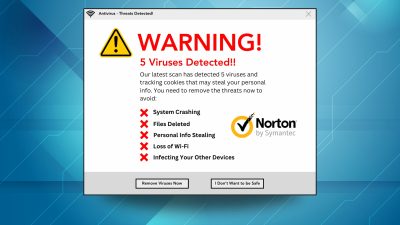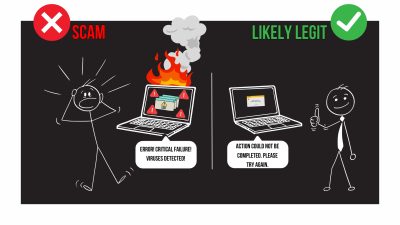Scareware: How to Recognize and Prevent Attacks

A guide to protect yourself from fake security alerts and malicious software.
Have you encountered or fallen victim to alarming pop-ups or banners suggesting a virus infection, security breach, or system malfunction?

When clicked upon, you may be directed to a website offering an instant solution—whether that be downloading software, calling a strange phone number, or making a payment. This is a scam. These types of traps are called “Scareware,” a type of hostile software that tries to scare you into taking an action that could compromise your security or privacy.
What is Scareware?
Scareware is a deceptive tactic designed to instill fear and panic, tricking victims into installing malicious software, divulging personal information, or paying for bogus services. Masquerading as legitimate security tools or system alerts, scareware often employs the logos and names of reputable companies to build trust.
These cyberattacks can infiltrate devices through phishing emails, infected websites, misleading ads, or corrupted downloads. Common examples include:
-
- Ransomware: This malicious software encrypts files and demands payment to restore access, threatening data loss or exposure.
- Tech Support Scams: These frauds falsely claim system damage or infection, urging victims to contact fraudulent support lines. Scammers may demand payment, remote access, or sensitive information.
- Rogue Security Software: Pretending to be legitimate antivirus programs, these scams falsely identify threats to extort payment for non-existent or ineffective protection.
- Fake Advertisements: Banner ads or any clickable ads on a website are a deception to receive personal information. Avoid interacting with ads for unfamiliar products.
By recognizing the tactics used in scareware attacks, individuals can protect themselves from falling victim to these cybercrimes.

Not all scareware will be urgent. Some may blend better than others with more accurate and calm verbiage. Always be alert and cautious with any pop-up you see on your device.
How To Prevent Scareware Attacks
Scareware can wreak havoc on your computer. Beyond immediate damage, it exposes you to identity theft, fraud, and additional malware. Safeguarding yourself from these threats is crucial. Here’s how:
-
- Prioritize Updates: Regularly install system, browser, and application updates to patch vulnerabilities exploited by scareware.
- Invest in Reliable Security: Use reputable antivirus, firewall, and malware protection. Conduct regular scans and strictly adhere to software recommendations. Ignore any alerts contradicting your security tools.
- Practice Online Vigilance: Avoid clicking on suspicious links, pop-ups, or downloads promising security solutions or free scans and do not call or contact suspicious phone numbers.
- When in Doubt, Close Out: Close suspicious windows and scan your device with your legitimate security software. Be wary of websites requesting notification permissions, as these can be linked to scareware. If you are able, close out of the browser or program using it’s own ‘X’ in the corner and avoid interacting with the pop-up at all.
- Protect Your Information: Never share personal or financial details in response to scareware prompts. Avoid paying for unsolicited services, licenses, or upgrades.
Seek Expert Assistance: If you suspect a scareware infection or have fallen victim to a scam, consult a trusted IT professional or security expert for removal, data recovery, and device protection.
Questions?
Scareware is a dangerous threat to your device, data, and finances. Protect yourself by following these tips. Remember, if something online seems too urgent, too good to be true, or overly alarming, it’s likely a scam. Always close out of suspicious windows or programs and never follow the “instructions.”
Want to spend less time worrying about scareware and more time enjoying the world wide web? Contact Catalyst IT today and deploy a team of experts to watch your back.


